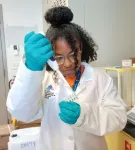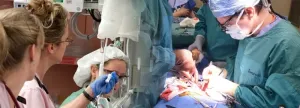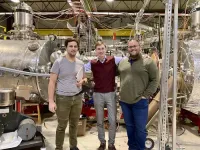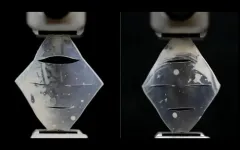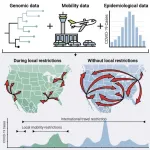(Press-News.org) UCL researchers have developed a new gene therapy to cure a devastating form of childhood epilepsy, which a new study shows can significantly reduce seizures in mice.
The study, published in Brain, sought to find an alternative to surgery for children with focal cortical dysplasia.
Focal cortical dysplasia is caused by areas of the brain that have developed abnormally and is among the most common causes of drug-resistant epilepsy in children. It frequently occurs in the frontal lobes, which are important for planning and decision-making. Epilepsy in focal cortical dysplasia is associated with comorbidities, including learning disabilities.
Although surgery to remove the affected brain malformation is effective, its use is severely limited by the risk of permanent neurological deficit and does not always result in seizure freedom.
Consequently, researchers at the UCL Queen Square Institute of Neurology evaluated a gene therapy based on the overexpression of a potassium channel which regulates neuronal excitability in a mouse model of focal cortical dysplasia in the frontal lobe.
Potassium channels control the movement of potassium ions in and out of cells. When there is an overexpression of a potassium channel, it means that there is greater regulation, resulting in the decrease of the activity of cells and, in turn, stopping seizures.
Co-corresponding author, Professor Gabriele Lignani (UCL Queen Square Institute of Neurology), said: “It is very exciting to see that this new gene therapy could potentially be used as an effective alternative to surgery in patients with focal cortical dysplasia.”
Gene therapies have previously been shown to work in another form of epilepsy where seizures arise in the temporal lobes, but have not been tested in focal cortical dysplasia.
In this case, the researchers introduced an engineered potassium channel gene called EKC into the affected frontal lobe of the epileptic mice. For added safety, they used a virus that is unable to replicate in order to carry the potassium channel gene.
Before giving the treatment, researchers monitored the mice’s brain activity for 15 days. They then injected either the virus carrying the EKC gene or a control virus into the affected brain area. The team then monitored the mice’s brain activity for another 15 days.
The researchers found that the gene therapy reduced seizures by an average of 87% when compared with the control group, without affecting the mouse’s memory or behaviour.
Lead author Dr Vincent Magloire (UCL Queen Square Institute of Neurology) said: “Following the successful study in mice, we believe the treatment is suitable for clinical translation, and, taking into account the size of the unmet need, it could be deployed to thousands of children who are currently severely affected by uncontrolled seizures.”
Co-corresponding author, Professor Dimitri Kullmann (UCL Queen Square Institute of Neurology) added: “Plans for a first in human clinical trial are underway and are planned in the next five years.”
The research was funded by Great Ormond Street Hospital Children’s Charity (GOSH Charity), the Medical Research Council, Epilepsy Research Institute UK and Wellcome.
END
New gene therapy could significantly reduce seizures in severe childhood epilepsy
Peer reviewed | Experimental study | Animals
2023-12-15
ELSE PRESS RELEASES FROM THIS DATE:
Mount Sinai receives $1.3 million from the National Institutes of Health to support program that introduces high school students to virus surveillance
2023-12-15
The Icahn School of Medicine at Mount Sinai has received more than $1.3 million from the National Institute of General Medical Sciences of the National Institutes of Health (NIH) to expand the New York City Virus Hunters program. The program engages high school students from communities historically underrepresented in science in the first large-scale citizen science effort to catalog and map circulating avian influenza and avian paramyxoviruses in New York City’s wild birds. The goal is to track emerging viruses and to prevent future outbreaks.
Wild birds can disseminate infectious ...
UM School of Medicine awarded up to $7.3M from DARPA to drive innovation in trauma triage technology, improve mass casualty response efforts
2023-12-15
In an effort to better optimize the triage of patients during mass casualty events, University of Maryland School of Medicine (UMSOM) researchers are receiving up to $7.3 million in funding from the Defense Advanced Research Project Agency (DARPA) for vital new research. The funding will be used to support a study that will collect data over the next 3.5 years on trauma patients with the aim of identifying and implementing lifesaving advancements in medical triage for large-scale mass casualty incidents.
“The importance of early interventions in trauma is described as the concept of the ‘golden ...
Transportation planning goes virtual
2023-12-15
Freight transportation is a backbone of the US economy — and a significant contributor to US greenhouse gas emissions. In fact, freight accounts for nearly 10% of annual U.S. emissions,ISE Dan Doulet Faculty Fellow and Professor Xueping Li points out. Li and an interdisciplinary, multi-institutional team have been awarded funding from the US Department of Energy to launch a first-of-its-kind, national-scale undertaking to address freight’s impact on climate change — and climate change’s impact on this vital sector.
Funding from DOE’s Advanced Research Projects Agency-Energy (ARPA-E) is highly competitive. “Any ...
Zhou’s new tech has low-income housing covered
2023-12-15
When looking for ways to reduce their carbon footprint, most people think of first of their car, not their house. Surprisingly, however, buildings make up one of the largest energy-consuming sectors of the US economy, accounting for 39 percent of the country’s total energy use.
“Heating and cooling are among the most energy-intensive parts of building operations,” said Associate Professor of Civil and Environmental Engineering Nick Zhou, who leads UT’s Sustainable and Adaptive Built Environment Group in ...
New framework to identify genetic risk of disease could lead to targeted therapeutics
2023-12-15
Genome-wide association studies (GWAS) on patient blood samples are useful for identifying the genetic basis of blood cell traits and their links to common diseases. While previous experiments have focused on characterizing clinical parameters such as cell count, few have evaluated the dynamic effects of factors—such as inflammation, microbiome or medications—on blood cell contributions to disease development and progression. This lack of insight into underlying biological mechanisms behind such chronic progressive conditions has hindered ...
Newly developed material gulps down hydrogen, spits it out, protects fusion reactor walls
2023-12-14
MADISON – University of Wisconsin–Madison engineers have used a spray coating technology to produce a new workhorse material that can withstand the harsh conditions inside a fusion reactor.
The advance, detailed in a paper published recently in the journal Physica Scripta, could enable more efficient compact fusion reactors that are easier to repair and maintain.
“The fusion community is urgently looking for new manufacturing approaches to economically produce large plasma-facing components in fusion reactors,” says Mykola Ialovega, a postdoctoral researcher in nuclear engineering and engineering physics at ...
Tufts University announces Second Annual Cellular Agriculture Innovation Day
2023-12-14
Tufts University, home to the world’s largest concentration of academic researchers working on cultivated meat, will be hosting its second annual Cellular Agriculture Innovation Day on January 11, 2024. The day-long event will be held at Tufts’ Joyce Cummings Center in Medford, following a year of major developments in the industry — including regulatory approval of cultivated meat in the United States. Bringing together researchers, entrepreneurs, policymakers, and investors, Cellular Agriculture Innovation Day is an opportunity for candid ...
DOE’s Office of Science releases vision outlining the path to advancing fusion energy science and technology
2023-12-14
Washington, D.C. – The Office of Fusion Energy Sciences (FES), at the U.S. Department of Energy’s Office of Science, announced the release of its vision, Building Bridges: A Vision for the Office of Fusion Energy Sciences, during the Fusion Energy Sciences Advisory Committee hearing on December 13, 2023. This FES vision enables DOE to establish the steps needed to help advance fusion energy, including addressing key science and technology gaps in the supply chain and industry, bringing the United States one step closer to achieving net-zero emissions by 2050.
Fusion, the process that powers ...
Rubber that doesn’t grow cracks when stretched many times
2023-12-14
Researchers from the Harvard John A. Paulson School of Engineering and Applied Sciences (SEAS) have increased the fatigue threshold of particle-reinforced rubber, developing a new, multiscale approach that allows the material to bear high loads and resist crack growth over repeated use. This approach could not only increase the longevity of rubber products such as tires but also reduce the amount of pollution from rubber particles shed during use.
The research is published in Nature.
Naturally occurring rubber latex is soft and stretchy. For a range of applications, including tires, hoses, and dampeners, rubbers are reinforced by ...
Social distancing was more effective at preventing local COVID-19 transmission than international border closures
2023-12-14
LA JOLLA, CA—Elucidating human contact networks could help predict and prevent the transmission of SARS-CoV-2 and future pandemic threats. A new study from Scripps Research scientists and collaborators points to which public health protocols worked to mitigate the spread of COVID-19—and which ones didn’t.
In the study, published online in Cell on December 14, 2023, the Scripps Research-led team of scientists investigated the efficacy of different mandates—including stay-at-home measures, social distancing and travel restrictions—at preventing local and regional transmission during different phases of the COVID-19 pandemic. They found ...
LAST 30 PRESS RELEASES:
Scientists boost cell "powerhouses" to burn more calories
Automatic label checking: The missing step in making reliable medical AI
Low daily alcohol intake linked to 50% heightened mouth cancer risk in India
American Meteorological Society announces Rick Spinrad as 2026 President-Elect
Biomass-based carbon capture spotlighted in newly released global climate webinar recording
Illuminating invisible nano pollutants: advanced bioimaging tracks the full journey of emerging nanoscale contaminants in living systems
How does age affect recovery from spinal cord injury?
Novel AI tool offers prognosis for patients with head and neck cancer
Fathers’ microplastic exposure tied to their children’s metabolic problems
Research validates laboratory model for studying high-grade serous ovarian cancer
SIR 2026 delivers transformative breakthroughs in minimally invasive medicine to improve patient care
Stem Cell Reports most downloaded papers of 2025 highlight the breadth and impact of stem cell research
Oxford-led study estimates NHS spends around 3% of its primary and secondary care budget on the health impacts of heat and cold in England
A researcher’s long quest leads to a smart composite breakthrough
Urban wild bees act as “microbial sensors” of city health.
New study finds where you live affects recovery after a hip fracture
Forecasting the impact of fully automated vehicle adoption on US road traffic injuries
Alcohol-related hospitalizations from 2016 to 2022
Semaglutide and hospitalizations in patients with obesity and established cardiovascular disease
Researchers ‘listen in’ to embryo-mother interactions during implantation using a culture system replicating the womb lining
How changing your diet could help save the world
How to make AI truly scalable and reliable for real-time traffic assignment?
Beyond fragmented markets: A new framework for efficient and stable ride-pooling
Can shape priors make road perception more reliable for autonomous driving?
AI tracks nearly 100 years of aging research, revealing key trends and gaps
Innovative techniques enable Italy’s first imaging of individual trapped atoms
KIER successfully develops Korea-made “calibration thermoelectric module” for measuring thermoelectric device performance
Diversifying US Midwest farming for stability and resilience
Emphasizing immigrants’ deservingness shifts attitudes
Japanese eels, climate change, and river temperature
[Press-News.org] New gene therapy could significantly reduce seizures in severe childhood epilepsyPeer reviewed | Experimental study | Animals
